You've opened Twitter or any of the pink papers or TV channels and stuff like 'Bond yields cross 7%' and RBI's action dominate the headlines. And you just want to skip ahead because stuff related to fixed income is too jargon-y and overwhelming? Even if you are a Commerce/ CA student who studied the definitions theoretically but didn't have the time to wonder on the practicality and real-world application of it? This post is just for you! I'm going to help you associate the fixed income theory you've studied with what transpires in the fixed income market outside of your SFM textbooks, the headlines from TV and newspapers on bonds and yields to help you associate the two together, and give more meaning to what you've studied. I hope by the end of the article, you'll boldly read all bond, yield and RBI-related news, be able to make sense of it and further polish your newly acquired knowledge. First, the basic....
WHAT IS A BOND?
As a finance student, you've studied this! It's a type of a loan taken by a company, country or a municipal corporation. The borrower, will come to the investor and say, "Hey! We need some money for XYZ purpose, can we borrow it for a fixed period, during which time we will pay you a fixed annual interest. When the period is over, we will return the original invested amount". Investor says, sure. Gives the borrower the money and gets a bond certificate for his/her troubles. That fixed interest by the way, is given a cool name - Coupon!
Now of course, the financial world is adept at creativity when it comes to catering to the differentiated requirements of both borrowers and investors. So they created different kinds of bonds:
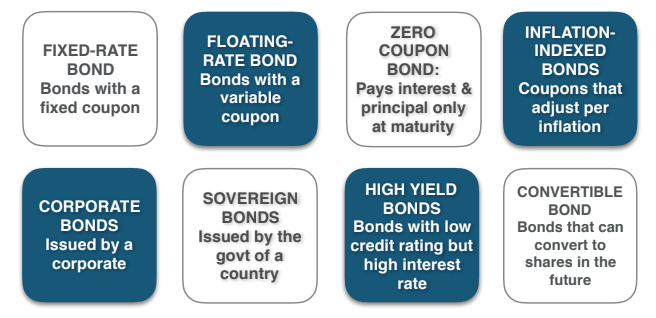
And when I say creative, the creativity is not just limited to the above 8. There are other kinds too like Foreign bonds - Samurai bond, Eurodollar bond, Subordinated bonds and so on.
ANOTHER IMPORTANT FACTOR IN BONDS
Credit risk is a big deal in bonds. The coupon rate is decided based on this factor. Credit risk is determining the credit worthiness of a bond i.e. the certainty that the borrower or bond issuer will pay the coupon and principal. It depends on things like the corporate health, the health of the Industry that the company operates in, in the case of sovereign bonds, on the macroeconomic factors of the country like CAD, forex reserves etc. The credit rating is issued by agencies like CARE Ratings, CRISIL, S&P, Moody's etc.
Credit rating standards are literally not standard! Different agencies have different definitions for a particular rating, though its not extremely different. You'll find the rating definition of different agencies on their respective websites. Here's how you can read credit ratings:
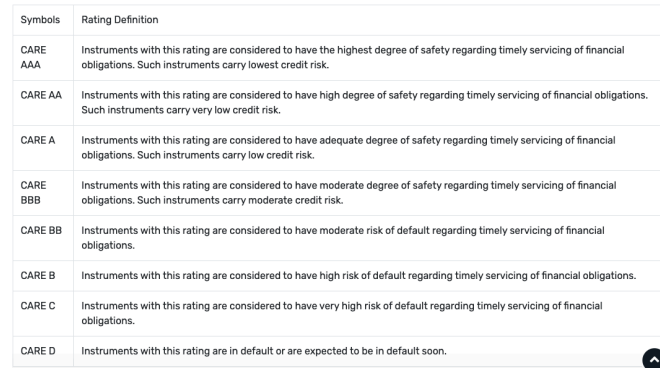
WHY CREDIT RATING CAN BE IMPORTANT!
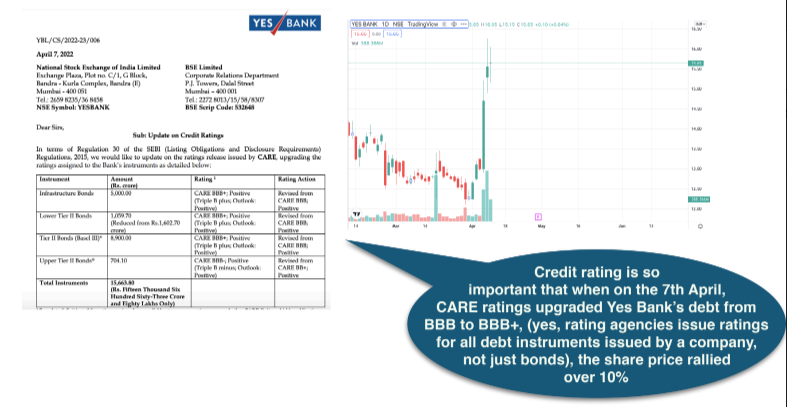
OKAY BACK TO YIELDS. WHAT IS YIELD!?
Bond yield or simply, yield is nothing but:
Fixed interest or coupon paid by a bond / Market price of a bond (Not the face value, but the market value)
You can compare it with dividend yield which is:
Dividend declared by company / Share price of company.
Now you may ask, how does the price of a bond change? Is there a market for it like there is for shares? Well, the market is not for bonds, but for yields! So change the equation a bit to make it look like this:

We know what a bond's coupon rates are because it is fixed. Yield is what is decided by the market. As you can decipher from the equation:
"If the yield goes up, the bond price will go down and vice versa"
SOVEREIGN BONDS
We're gonna zero in our focus on sovereign bonds because that's what dominates the headlines. As the name suggests, it is a bond issued by a country. The money is used for govt activities like infra spending, meeting deficits and other programs. So the Indian govt issues bonds with a certain Face value. They are often called G-secs. The RBI conducts auctions on an electronic platform called the E-Kuber, the Core Banking Solution (CBS) platform of RBI. Commercial banks, scheduled UCBs, Primary Dealers who maintain funds account (current account) and securities accounts (Subsidiary General Ledger (SGL) account) with RBI, are members of this electronic platform. So in many ways, these guys are the market makers for the bond market. The RBI conducts 2 kinds of auctions: Yield-based and price-based.
1. YIELD-BASED: When a new G-sec is Investors bid in yield terms up to two decimal places (e.g., 8.19%, 8.20%, etc.)
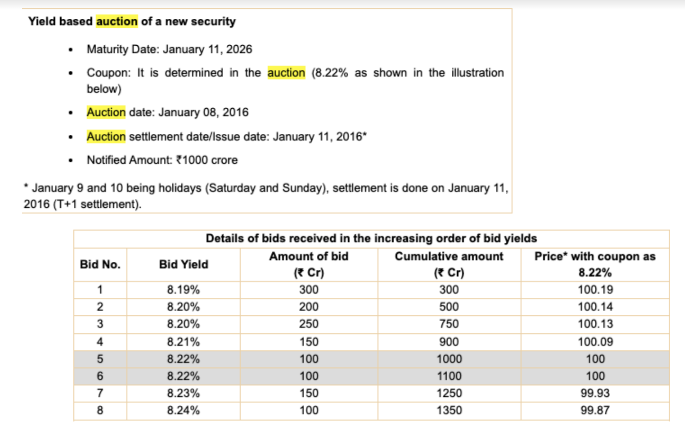
Source: RBI
2, PRICE BASED: When GoI reissues securities which have already been issued Bidders quote in terms of price per ₹100 of face value of the security
Now obviously the RBI wants to get the best i.e. lowest cost borrowing for the govt, hence it will pick up bids in decreasing order.
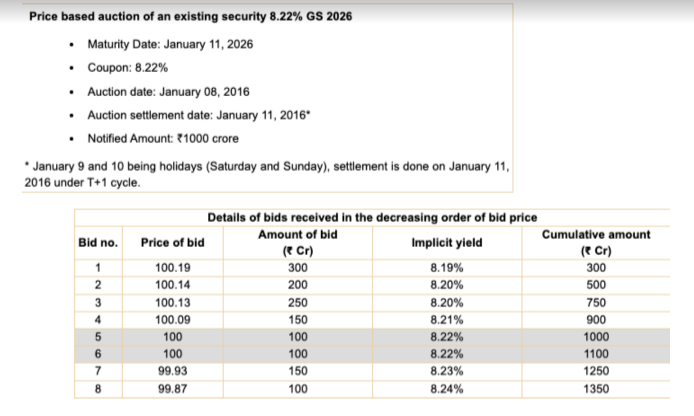
Source: RBI
This is the news piece you may have seen recently. So the next time you read 'auction of govt securities' you know what they're talking about.
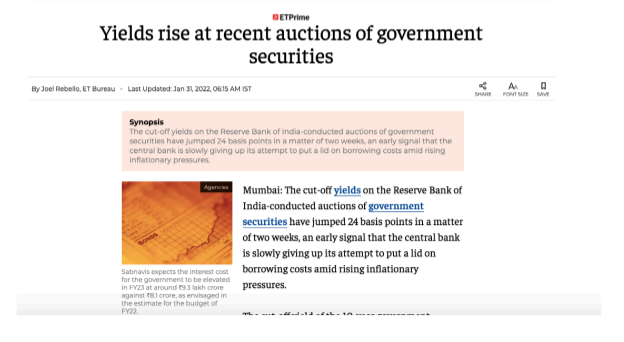
OKAY, I UNDERSTOOD G-SECS AND YIELDS. NOW WHAT IS THIS APPEARING ON MY SCREEN?
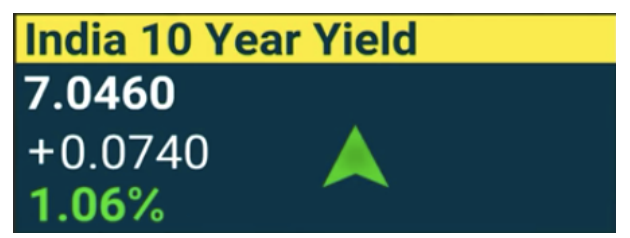
Courtesy: BloombergQuint
This is the Nifty and the Sensex of the bond market! Just how the Nifty and Sensex and benchmarks for India's equity markets,
"The benchmark for the Indian bond market is the 10-year yield (for the bond issued by the Govt. of India.) You'll also see this appear as 10-yr GOI or 10-yr Gsec"
Let's break it down further
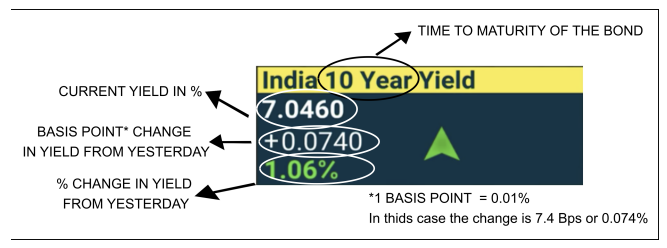
This quote basically means that on this particular trading session, the yield has gone up, meaning, bond price has gone down.
A LITTLE MORE ON THIS BOND AND ITS IMPORTANCE
It carries a coupon of 6.54% and its maturity date is 17 Jan, 2032. So this means that the yield on a 6.54% coupon paying bond is now above 7%. It influences the cost of borrowing - from the cost of mortgage to the cost of borrowing by businesses. But it also is an important barometer for the economy and an indicator of its health.
DECIPHERING RECENT EVENTS AND NEWS AND HOW IT IMPACTED THIS YIELD FIGURE
1. RBI MONETARY POLICY AND ACTION
The RBI decides on interest rates in the economy, also called as Repo rate, once every 2 months. If they slash the Repo (More on this below), say from 4% to 3% (the increase or decrease is never of such a big quantum practically speaking, unless there is a HUGE event. During COVID, RBI cut repo by 0.75% or 75 bps), then a bond which carries a coupon of 4.5% becomes extremely attractive, this will lead to its price rising and the yield falling. So a cut in Repo usually equals a fall in yield and vice versa. You can read more below But the market just doesn't look at action of the day, it looks at whether the RBI is
- Hawkish (looking to increase rates in the future)
- Dovish/Accomodative (looking to decrease rates in the future)
On the 8th of April, RBI let interest rates remain unchanged. Why do we read this headline then?
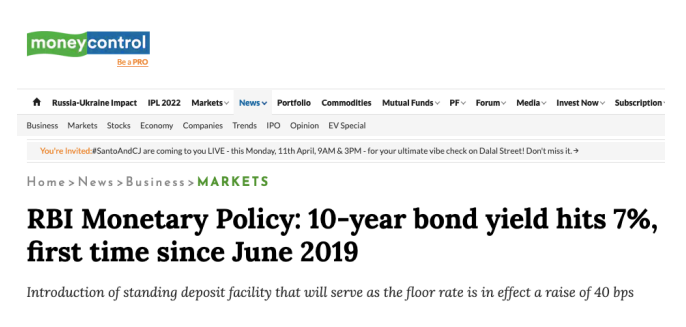
Because the RBI uses Repo rates, not just to push economic activity but also to manage liquidity. And it was an announcement to that extent which led to the above move. Keep reading..
2. LIQUIDITY MANAGEMENT BY RBI
THE NEWS

Source: Financial Express
THE IMPACT
Yields surged to beyond 7%
Through Repo and reverse repo. the RBI also controls liquidity REPO: Rate at which banks borrow from RBI
Reverse Repo: Rate at which banks can deposit their excess cash with RBI
If the market is in distress or growth is slowing down (As was forecast to happen when a COVID like event hits), RBI will cut the above rates to encourage businesses to borrow and expand to get the economy going. If there is too much liquidity in the market, or in case of inflation, the RBI will
increase repo and reverse repo, so banks and others will be discouraged from borrowing. The latter is what the RBI has recently done but in a different way. The RBI introduced a 'liquidity absorption tool' at 3.75% called the standing deposit facility. As the name suggests, it will absorb liquidity. This works like the reverse repo, which currently stands at 3.35%. The SDF allows banks to park their excess money, just like they do with reverse repo, but without any need for collateral, which is needed in case of reverse repo. This is being done because the system is flush with extraordinary liquidity, infused in the wake of the pandemic, which in turn has been one of the reasons for higher inflation! The SDF is move towards increasing (or tightening) policy rates in the months to come which in turn will lead to yields rising, as explained above. Like I said, the creativity in the financial market is endless. But when the RBI uses extraordinary tools like this, the governor usually explains it in the press conference which follows such announcements so don't be too flustered.
The RBI also uses g-secs to control liquidity in the market. It often comes out with tools called GSAP or G-Sec Acquisition programs and buys bonds from the market. This increases liquidity in the market, removes bonds from the market and lead to a fall in yields. This is similar to what the US does via its 'Quantitative easing' or QE program.
3. INFLATION
THE NEWS
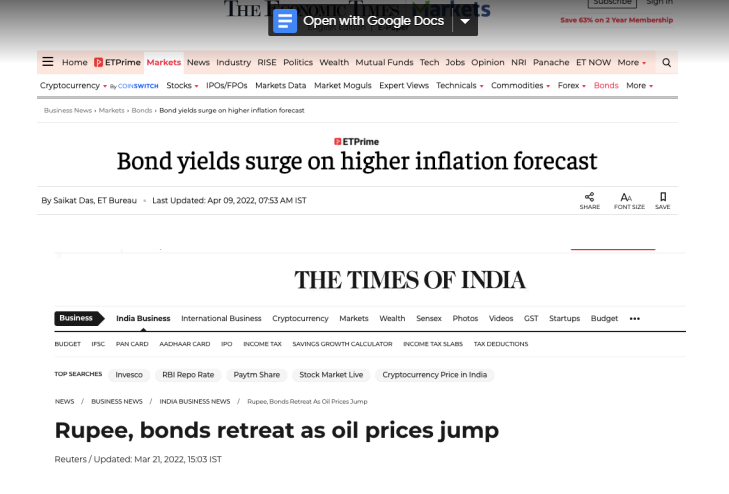
THE IMPACT
Yields will go up
This one should be a no brainer. As stuff gets expensive, investors will want more from their investments to pay for all that expensive stuff. When we see global crude oil prices surge or even the US inflation number come in at a whopping 7% compared to its usual 2%, our yields will spike. The RBI governor increased the inflation forecast, and that was an added reason, apart from the liquidity sucking standing deposit facility mentioned above, for the yields to spike. Obviously, if the governor has said inflation is going to be higher than previously estimated, the governor will hike rates, as explained above, to manage it. This will lead to higher yields.
4. GOVT'S HALF-YEARLY BORROWING CALENDAR RELEASES
THE NEWS
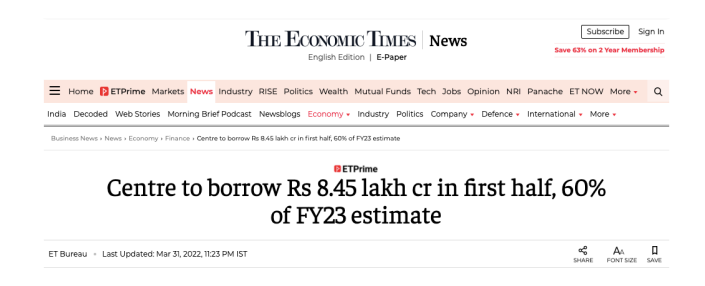
THE IMPACT
The 10-year yield shot up 9 basis points to 6.93%
FM Sitharaman, in her budget had announced a massive Rs. 14.95 lk cr borrowing via issuance (also called as sale) of bonds for the entire year. Now, a majority of it will come up for sale (auction, as mentioned above) in the period April-Sept. You may wonder how to make sense of these numbers - Who determines that 14.95 lk cr is small or big. Well as you will track the market, you will get the knack of it. Anyway, here's where basic demand-supply comes into play. Since the borrowing figure is so huge, it means a big chunk of govt bonds are set to hit the market. More the supply, lower the price i.e. higher the yield.
HOW YIELDS IMPACTS SHARE MARKET
A higher bond yield is bad for equities theoretically. Borrowing cost for companies will get expensive, affect corporate profitability. But one must also remember why bond yields are changing and not just the direction of change. Ridham Desai, equity strategist at Morgan Stanley in a recent note explains it well:
"Bond yields reflect the growth and inflation mix in the economy. If growth is strong, bond yields are usually rising. They also rise when inflation is going higher. The impact of these two situations is different for equities"
When growth is strong, the impact of higher growth in terms of cash flows or, more precisely, dividends more than offsets the negative impact of the rise in yields, causing equity share prices to trade higher
"To the extent that growth accelerates in the coming months faster than the rise in bond yields, share prices should be fine," says Desai.








 CAclubindia
CAclubindia

